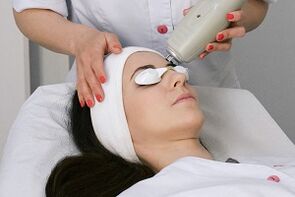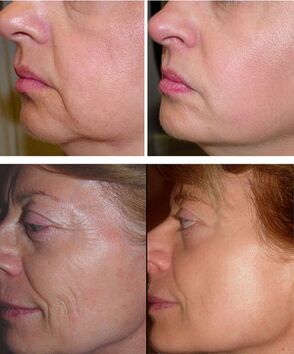
The facial skin inevitably undergoes a natural aging process that can be resisted by modern cosmetics and cosmetic procedures.
One of these procedures is laser facial rejuvenation - thanks to the technique, the mechanisms of rejuvenation and cell restoration are started, the facial skin acquires a young, fresh and well-groomed appearance.
In cosmetology, a special laser is used to eliminate various skin problems. Fractional laser skin rejuvenation is quite popular - a cosmetological procedure after which you can increase the elasticity of the skin, eliminate fine and deep wrinkles and tighten the oval of the face. You will look several years younger after completing the courses.
The essence and effect of the technique

Laser facial skin rejuvenation is a technique in which laser radiation acts on the skin. To do this, a laser source - a laser device - is used for a device that allows the depth of penetration of the laser beam into the skin, the adjustment of the exposure time and the radiation temperature.
The correct choice of the parameters of the procedure is the most important condition for successful rejuvenation, as burns can appear on the face with the slightest mistake of the beautician.
Upon penetrating the tissue, the laser beam causes mild damage to the cells, in response to the irritation that occurs, the cells begin to actively produce collagen and elastin, and new cells continue to proliferate.
Stimulation of the regeneration processes leads to the complete renewal and renewal of the facial skin. The second name of the procedure is laser peeling.
Indications and contraindications
The technique is used to eliminate such age-related changes in facial skin:
- Wrinkles.
- Dark spots.
- He limped and sagged.
The indications for the procedure are as follows:
- Scars, bumps on the face.
- Acne.
- Unwanted tattoos.
- Keratinization of the skin.
- Enlarged pores.
- Mesh on the face.
- Stretch marks on the abdomen and legs after pregnancy.
Contraindications to laser peeling:
- Keloid scars.
- Malignant tumors.
- Pregnancy, breast-feeding.
- Herpes infection during exacerbation.
- Wounds and abrasions on the face.
- Any skin disease.
- Fresh tan.
- Moles.
- Taking medications to treat acne.
In most cases, laser rejuvenation occurs without complications, with the patient experiencing mild swelling, redness, and peeling in the first days after the procedure. These phenomena are normal for laser peeling and go away on their own after a few days.
Possible side effects

However, in some cases, the following side effects may occur:
- Permanent blush.
- Exacerbation of acne.
- Increased skin oiliness.
- Appearance of hyper- or hypopigmentation.
- Herpes outbreaks (if the patient has previously been diagnosed with herpes).
- Burn.
- Maintaining the boundary between treated and untreated skin areas.
- Subcutaneous bleeding.
The listed side effects disappear for a long time and require further treatment from a beautician.
Advantages and disadvantages of peeling
Fractional peeling is widely used due to the following advantages:
- High efficiency, ability to eliminate significant aesthetic flaws.
- Possibility to perform any type of skin.
- Minimal risk of side effects (burns and hyperpigmentation).
- Pain relief.
- Short duration of skin recovery.
- It can treat large areas of the skin in one go.
The disadvantage of fractional peeling is that it is high in cost compared to other methods, but in terms of the effectiveness of the process, this disadvantage can be considered insignificant.
Types of laser rejuvenation
Depending on the depth of laser penetration, there are several types of laser rejuvenation:

- Laser renovation. . . The laser "works" in the surface layer of the epidermis, peeling off dead cells. The result of the procedure becomes noticeable after a week: the skin becomes velvety to the touch, the fine wrinkles disappear. The process uses three types of laser beams: erbium, carbon, or neodymium.
- Laser biorevitalization. . . The radiation penetrates the deep layers of the skin while some cells are killed. The technique is tougher than laser renovation, but provides a strong anti-aging effect. To enhance the effect of the laser, apply a mixture of cosmetic nutrients to the skin. After the procedure, the deep wrinkles disappear and the contour of the face improves. Recovery after biorevitalization occurs within three months, during which time edema and severe exfoliation of the epidermis may persist.
- Fragmented peeling. . . Fractional laser rejuvenation is the most effective and gentle method. The peculiarity of the method lies in the fact that the laser beam is divided into many microwaves, as a result of which it has a softer effect on the skin. The radiation reaches the skin in the form of a mesh, so intact cells remain among the foci of cell damage - contributing to faster tissue regeneration and a stronger rejuvenating effect. The strength of the beam can be varied during fractional peeling with a carbon dioxide or erbium laser.
Stages of the procedure
You should see an appointment with a cosmetologist before performing the procedure. The doctor identifies the problems that exist, asks the patient if there are any contraindications to the procedure, and talks about how laser rejuvenation will take place.
If the patient’s skin is prone to increased pigmentation, a whitening cream is prescribed a few days before the rejuvenation session. The patient should be aware that they should not exercise, drink hard, or drink alcohol before the procedure.
Order of fractional peeling:
- The face is cleansed with the help of traditional cosmetics.
- An anesthetic cream is applied to the skin.
- After a few minutes, the anesthetic is washed and a gel is applied to facilitate sliding of the nozzle of the fractionated device. Glasses are placed on the patient's eyes.
- The doctor moves the nozzle over the face, laser-influencing each area in sequence.
- The treatment lasts 15-60 minutes, after which a soothing cream is applied to the skin.
In total, you have to go through 3-4 procedures, with a break between them of 1-2 months.
Homemade skin care

After laser treatment, swelling, redness, peeling and itching appear on the skin, later crusts form. Patients should follow these recommendations:
- Apply a cold compress to the face to relieve swelling.
- Apply anti-inflammatory and soothing creams to the skin (prescribed by the beautician).
- Use sunscreen on your face before going out.
- Do not go to a bath, sauna or hot bath for two weeks after the procedure.
- Do not use scrubs; use cosmetics only with the beautician's permission.
- Do not remove formed bark to prevent scars from appearing on the face.
If the laser rejuvenation is performed by a highly trained professional and the patient follows all the recommendations of the doctor, the result of the procedure will have an excellent cosmetic effect.















































































